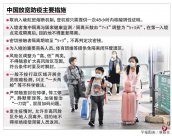Chang Jile Chang Jile, deputy director of the National Centers for Disease Control and Prevention on Saturday (November 12), interpreted at a press conference on the joint prevention and control mechanism of the State Council to interpret "no longer judging the secondary connection", "cancel the central risk zone", etc.When optimizing Article 20 of the prevention and control measures, the evaluation found that the positive detection rate of the secondary densely connected is very low.Public policy must be lightly harmful, so it will no longer be judged to be closely connected.Similarly, after the central risk zone, there are more controlling personnel and consume the epidemic prevention personnel.Therefore, in this case, it is also a decision to take the two harm.
According to the China Network, Chang Jile said that the ninth edition of the prevention and control plan was officially released on June 28 this year. The ninth edition actually began to have prototypes in March this year.From April 5th to May 5th, China Disease Control piloted the prototype of the nine editions in 7 cities across the country.At that time, the major strains in China were Omikon BA.1 and BA.2. After the pilot result was the last exposure of the positive infection of close contact, the proportion of positive detection within 5 days was 89.1%, and 7 days were 97.3%.EssenceSo the nine editions are "7+3".
After the release of June 28, the plan was evaluated in July and August. At that time, the main popular strains in China were Omikon BA.5 and BA.5.2, BA.2.76.The assessment found that the proportion of positives in close contact within three days was 81.4%, 90.1%in 4 days, 94.5%in 5 days, and 99.7%in 7 days.Based on these results, the isolation period is further optimized to "5+3".This process sounds less than 2 days, and can save about 30%of centralized isolation resources in these two days.At the same time, because Omikon's longest incubation period is 8 days, "5+3" is used.
For the cancellation of the decisive judgment, Chang Jile said that the assessment found that the positive detection rate of the secondary secret is very low, about 3.1/100,000, that is, 3 of 100,000 people.Those who determine and control close contact in a timely manner can reduce the positive rate of secondary dense connection.Based on this situation, the second -secret is not managed or judged, which can save a lot of services that guarantee many service guarantee.The public policy of China ’s illness and control must be used for both the rights, so it is no longer determined that the secondary is densely connected.
In addition, the judgment of the central risk zone is canceled. Chang Jile said that the ninth edition is unified into high risk, medium risk, and low -risk areas.After the ninth edition of practical applications and the evaluation in July and August, the positive detection rate of the mid -risk zone was 3/100,000, and the sub -dense connection just mentioned was 3.1/100,000.China ’s disease control believes that there are risks, but not much.At the same time, after the central risk zone, there are more controlling personnel and consume the epidemic prevention personnel.Therefore, in this case, the two harm is also light, and decided to cancel the central risk zone.
For example, the overflowing person in high risk areas, it turned out to be a concentrated segregation in 7 days, and now it is adjusted to 7 Heavenly House isolation.The risk of overflowing personnel is about 49/100,000 after evaluation, but these per capita detected within 7 days after the risk areas are scheduled.Therefore, the person with overflowing high -risk areas is to be separated from 7 days to the 7 Heavenly House isolation. Considering that he is well controlled after arriving at the community, and saves centralized isolation resources.
In addition, for high -risk personnel who have closed -loop management operations, from the original 7 days of centralized isolation or home isolation for 7 days, to 5 Heavenly Home Health Monitoring.In the future, I have adjusted. This time, if high -risk personnel who are in closed -loop management, if the closed -loop management measures are strictly implemented, these people's positive infection rates are very low, only 1.6/100,000, which is more than the medium risk and sub -secrets just mentioned.To be low.In this case, it can be adjusted into the health monitoring of 5 Heavenly Home.
Chang Jile emphasized that all adjustments are based.Maybe everyone heard the original "7+3" changed to "5+3", do you think it was loose?In fact, not only is it not loose, but the demand is higher.These adjustment requirements should be more scientific, more standardized, and faster in the prevention and control work. It is necessary to control the key risks that should be controlled.Existing resources improve the efficiency of prevention and control, and better coordinate the prevention and control of the epidemic and economic and social development.
The 20 optimization measures announced by China's official Friday have greatly relaxed the epidemic prevention policy, including the cancellation of the melting mechanism of entry flights, and the management measures for the "7 -day centralized isolation+3 Heavenly House" management measures to be adjusted to "5The heavenly concentrated isolation+3 Heavenly House isolation "has adjusted the risk zone from three categories:" high, medium, low "to" high, low ", and so on.


